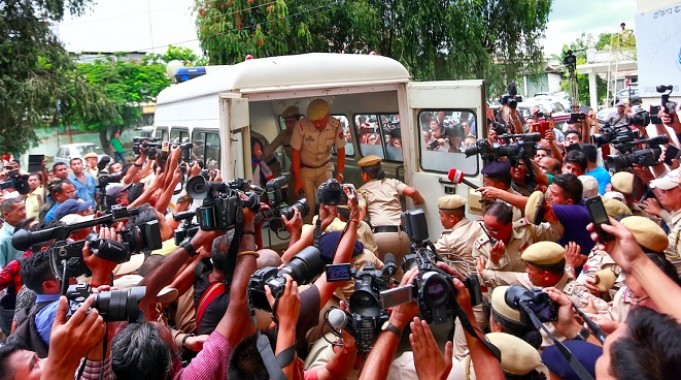Has the media failed Sharmila?
Photo caption: Journalists in Imphal the day Irom Sharmila broke her fast.
On 9th August, 2016 many journalists including me survived a stampede like situation at the Cheirap Court Complex of Imphal East, the capital city of Manipur. The reason being Irom Sharmila was about to break her historic 16 years of hunger strike against the Armed Forces Special Powers Act (AFSPA) as she was being produced before the Chief judicial magistrate Lamkhanpau Tonsing. No, the stampede like situation was not because of her supporters present there, very few were present there actually, but because of the 50-plus number of journalists from all over the world vying to get near her with their cameras big and small. It was an unprecedented situation which led one of Sharmila’s closest aides all these years to remark that the aura around Sharmila has definitely grown over the years since she started her fast before a single camera 16 years ago.
But in 16 years, has the media- national as well as the international -managed to go beyond her fasting and bring out the real ground stories of the region concerning the AFSPA? Hadn’t it become a yearly affair of churning out few stories on Sharmila and her personal life whenever she was released for a day or two after every year-long imprisonment at the prison ward of JNIMS, Imphal?
A few hundred meters from this chaos at the Cheirap Court Complex of Imphal East, something very significant was going on concerning AFSPA, extra-judicial killings and Manipur. Very few knew about it, especially the parachuted journalists from the mainland India, let’s not talk about the international media. They had no idea or interest in whatsoever in what was going on so close to them. After the Supreme Court’s historic judgment on 8th July, 2016 that the army or Manipur police cannot indulge in excessive force under the provisions of the AFSPA and cannot be an excuse for extra-judicial killings, the ongoing documentation process under Extra Judicial Execution Victim Families’ Association Manipur (EEFAM) has to be one of the most significant developments of modern day Manipur in its struggle against AFSPA. An ongoing process of documenting 1528 cases of extra-judicial killings in Manipur is underway at the EEFAM office premises as per the Supreme Court order.
Scores of widows and orphans from different regions of Manipur are coming over every day to the EEFAM office everyday to register their cases, to tell their unheard stories. Why has the mainstream media failed to highlight them? Why is it that in anything regarding AFSPA and Manipur, they can’t see beyond Irom Sharmila’s hunger strike? Is this also the reason why Sharmila has failed over the years and has finally decided to end her fasting? When Sharmila laments that the people have made her a saint and superhuman figure, isn’t the mainstream media also playing a role in the whole thing by turning blind to the real stories behind AFSPA and extra-judicial killings of Manipur?
Is this another form of the same kind of neglect that the big media houses located at Delhi and Mumbai have employed towards Kashmir as they have turned a blind eye to the sufferings of the common people? Most of the news reporting concerning the AFSPA in Kashmir has been limited to the reporting of stone pelting and clashes between the government forces and the protestors who are often declared as terrorists or supporters of terrorism. Similarly AFSPA reporting from Manipur has been limited to Irom Sharmila and her inhuman effort of hunger strike against AFSPA for the last 16 years. Do the national and international media know that many families in Manipur didn’t even have the means to file an FIR or get a postmortem done when their sons or husbands were killed in extra-judicial encounters under the AFSPA? Do they know that many senior officials of the Manipur police and the government seem to have ordered these killings as a recent startling confession by an ex-commando of Manipur police, Thounaojam Herojit has revealed?
60 people have died, over 200 injured and hundreds maimed over the last few weeks in Kashmir. Local media that have a completely different narrative from their national counterpart have been banned and press freedom has become directly proportional to the way news is being reported from Kashmir. Anything that is not in compliance with the official Delhi version seems to be declared anti-national and banned.
The role of the media since 16 years ago, when Sharmila started her hunger strike before a single camera, has certainly changed and become more central to the national narrative at the present times when she broke the fast on 9th July, 2016. Whatever is happening in Kashmir and in the northeastern states of India must be brought out sincerely to the national and international level, discussed, analyzed and solutions sought by the media. Unless and until that happens the so called fourth pillar of democracy is simply not doing its duty and has no right to be claimed as an integral part of a democratic country and vice versa.
